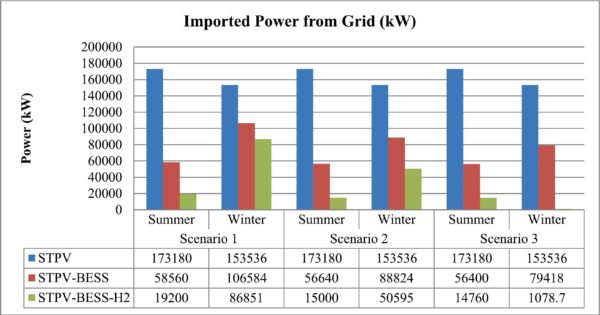A research team led by scientists from Turkey’s Final International University has developed a self-powering greenhouse that utilizes a semi-transparent PV (STPV) system, a battery energy storage system (BESS) for short-term energy storage, and hydrogen for long-term storage.
The size of the proposed system was optimized to maximize net present value (NPV) and minimize energy dependency (ED) on the grid.
“Previous studies highlight the potential of STPV systems, which serve a dual function by allowing sunlight to pass through for photosynthesis while simultaneously generating electricity. Despite this advantage, there is a recognized lack of energy availability during winter months in greenhouses,” the team explained. “By incorporating both BESS and hydrogen as part of a hybrid energy storage solution, this research provides a comprehensive approach to addressing seasonal energy dependency and optimizing energy management throughout the year.”
The system was designed to use STPV with an efficiency of 7%, with a cost per 32 W panel of $100. The BESS is based on lead acid, with charging and discharging efficiency of 80% to 90% and a price of $500/Kw. The electrolyzer has an efficiency of 80% and a cost of €388 ($408)/kW; the hydrogen storage system has an efficiency of 90% and a price of $10/kW; and the fuel cell has an efficiency of 60% and a price of €395/kW.
The assumed grid electricity rates are $0.43 per kWh in peak demand, $0.12 in off-peak, and $0.3 in intermediate demand.
The GBO algorithm optimizes the system based on three scenarios: the first prioritizes financial profitability, meaning higher NPV; the second strikes a balance between profitability (higher NPV) and energy independence (low ED); and the third tries to achieve maximum energy independence, meaning the lowest possible ED. Solar irradiance data for the summer and winter of Qatar was gathered and used.
“GBO is an efficient and powerful algorithm that uses two basic search strategies: exploitation and exploration. The exploitation search technique focuses on finding local optima, ensuring detailed and refined searches within a specific search space region,” the academics explained. “In contrast, the exploration search technique aims to discover global optima by broadly searching across the entire solution space.”

Image: Final International University, Journal of Energy Storage, CC BY 4.0
The scientists found that the first-case scenario requires an STPV area of 8,500 m2, a BESS capacity of 150 kW, an energy rating of 240 kWh, and hydrogen storage of 4,436.4 kg. In this case, the NPV would be $1,584,800, with an initial investment of $1,304,006. The system will have an ED rate of 15.07% and import 19,200 kW of power from the grid in the summer, 62.76%, and 86,851 kW in the winter, respectively.
The second scenario optimization was found to require an STPV area of 12,750 m², a BESS capacity of 225 kW, an energy rating of 360 kWh, and hydrogen storage of 8,763.6 kg. In this case, NPV would be $1,483,500 with an initial investment of $2,007,900. The system will have an ED rate of 10.64% and import 15,000 kW of power from the grid in the summer. In the winter, the ED rate will be 40.09%, importing 50,595 kW.
Finally, the third scenario requires an STPV area of 27,200 m², a BESS capacity of 480 kW, an energy rating of 768 kWh, and hydrogen storage of 23,476 kg. In this case, NPV would be—$98,223 with an initial investment of $4,401,100. The system will have an ED rate of 10.31% and will import 14,760 kW of power from the grid in the summer. In the winter, the ED rate will be 1.56%, importing only 1,078.7 kW.
“Scenarios emphasizing minimal ED result in negative NPVs, underscoring the trade-offs between achieving energy independence and maintaining financial viability,” the team concluded. “This dual-focus optimization not only enhances the economic viability of greenhouse energy systems but also promotes sustainability and energy independence, providing valuable guidance for developing sustainable and financially viable greenhouse energy management strategies.”
The results were presented in “Towards a self-powering greenhouse using semi-transparent PV: Utilizing hybrid BESS-hydrogen energy storage system,” published in the Journal of Energy Storage. Researchers from Turkey’s Final International University, Qatar’s Ministry of Municipality and Qatar University, and Egypt’s Arish University conducted the study.
This content is protected by copyright and may not be reused. If you want to cooperate with us and would like to reuse some of our content, please contact: editors@pv-magazine.com.



By submitting this form you agree to pv magazine using your data for the purposes of publishing your comment.
Your personal data will only be disclosed or otherwise transmitted to third parties for the purposes of spam filtering or if this is necessary for technical maintenance of the website. Any other transfer to third parties will not take place unless this is justified on the basis of applicable data protection regulations or if pv magazine is legally obliged to do so.
You may revoke this consent at any time with effect for the future, in which case your personal data will be deleted immediately. Otherwise, your data will be deleted if pv magazine has processed your request or the purpose of data storage is fulfilled.
Further information on data privacy can be found in our Data Protection Policy.